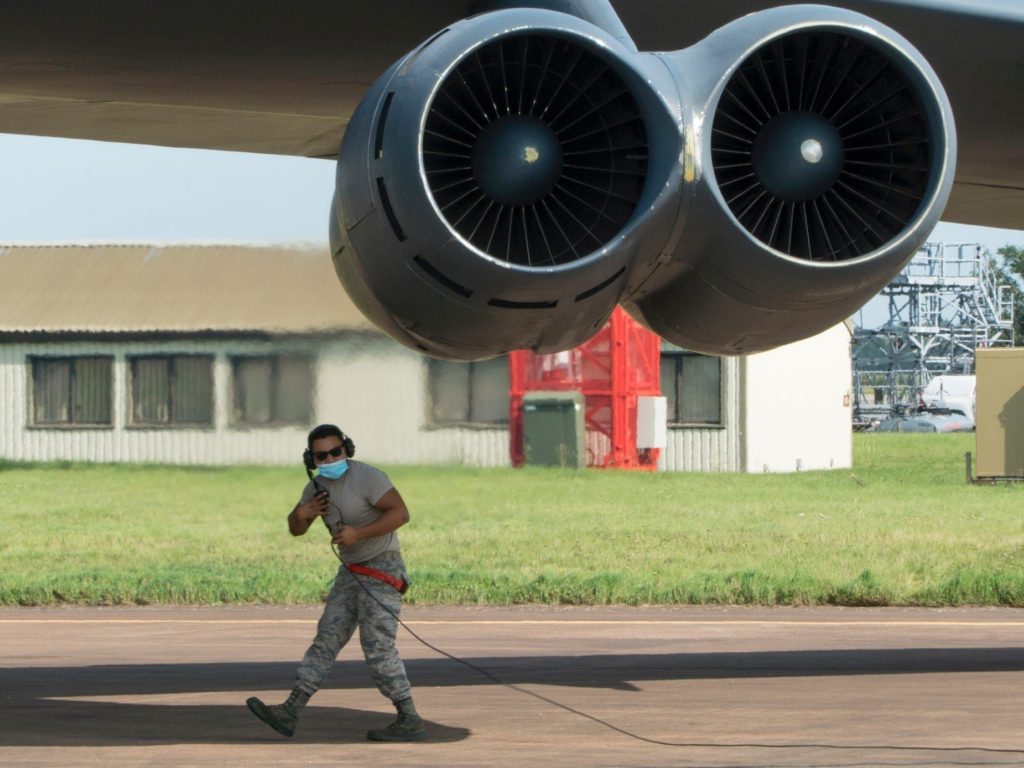[ad_1]
A US Air Force B-52 after aerial refueling over the North Sea during a Bomber Task Force Europe mission, September 25, 2020. US Air Force/Airman 1st Class Jessi Monte
Even with the ongoing coronavirus pandemic, the Air Force’s bombers are still flying around the world to reassure allies and caution rivals.
For six B-52s and their aircrews who recently deployed to Europe, pandemic-related restrictions meant they faced a “contested, degraded environment,” the mission’s commander told Insider.
Visit Business Insider’s homepage for more stories.
North America and Europe continue to struggle with the spread of COVID-19, which has affected military operations on both continents. For US Air Force bomber crews, who are still flying missions around the world, the pandemic is a challenge that they just have to work around.
This spring, Air Force leaders reviewed their mission-critical tasks to see which could be paused. Air Force bombers have continued their operations in Europe and the Indo-Pacific region, where they’re part of a broader effort by the US military to reassure allies and send a message to rivals — Russia and China, specifically.
Those bomber missions are being conducted in a “contested, degraded environment,” according to Lt. Col. Michael Middents, who commanded a Bomber Task Force mission in Europe from late August to late September.
“I emphasize the degraded part of that,” Middents told Insider in an interview this month. “If it was a regular day — no COVID, no concerns — you’re walking around in your normal patterns.”
Airmen from the 5th Bomb Wing at Minot Air Force Base in North Dakota board a jet to deploy to RAF Fairford for a Bomber Task Force Europe mission, August 24, 2020. US Air Force/Airman 1st Class Josh W. Strickland
About one-third of US military installations are still under travel restrictions related to the pandemic; those 81 bases are adhering to local health guidelines and have to have a 14-day decline in symptoms and cases before reopening.
Travel restrictions have been lifted at Minot Air Force Base in North Dakota, the home of the six B-52 bombers from the 5th Bomb Wing that Middents led to Europe, but remain in place at other major facilities, including Ellsworth Air Force Base in South Dakota, Ramstein Air Base in Germany, and several air bases in Japan.
The B-52s, operating from RAF Fairford in southern England, flew all over the continent, from the Arctic to the Mediterranean and as far east as the Black Sea, where they had what the Air Force deemed an “unsafe and unprofessional” encounter with Russian fighter jets.
“The thing about COVID is we’re still learning quite a bit about it day to day,” Middents said. “The policies that we try and make between host nation, the US, and even internally within the Department of Defense … the challenge that we have is to try and make sure that we are in compliance with those policies while also getting the mission done.”
A B-52H crew chief surveys an engine during start-up at RAF Fairford during a Bomber Task Force Europe mission, September 10, 2020. US Air Force/Master Sgt. Burt Traynor
That challenge “means that we can’t always stick to the same timelines, the same procedures. We need to figure out how to plan a little bit differently,” Middents added.
Precautions in place across the Air Force include standard good practices, like wearing masks and washing hands, but the need to social-distance and, at times, isolate means changes for what bomber crews can do and where they can go.
“We try not to congregate the entire squadron all at one place at one time,” Gen. Charles Brown, the Air Force chief of staff, told Insider at a media roundtable during the Air Force Associate Conference in September.
“We were doing blue- and silver-type teaming really across the Air Force so we could … ensure that we had the capability to generate air power, and if someone got sick that we … didn’t wipe out an entire unit,” Brown said.
Restrictions are also in place for deployed bomber crews and support personnel. “You don’t get a chance to go downtown. You’re pretty much stuck on base, and so that’s a key aspect,” Brown added.
A US Air Force B-52H pilot during aerial refueling over the Mediterranean Sea on a Bomber Task Force Europe mission, September 16, 2020. US Air Force/Senior Airman Jennifer Zima
Middents said the bombers deployed to Europe were operated by “hard crews,” which meant that rather than mixing flight crews, the pilots, navigators, and weapons officers assigned to each bomber remained the same.
“In doing that, I have a little bit less flexibility on how I can put crews together, but then I mitigate the exposure to any viruses out there,” Middents told Insider. “If one crew goes down with COVID for 10 days, then I can keep another crew flying and healthy and safe. The entire squadron doesn’t get infected.”
There were positive cases within the task force while it was deployed to Europe, Middents said, but they were able to isolate and still contribute.
“Of those that were exposed or that tested positive, they went into a restriction of movement and actually for the most part were able to support the mission from their rooms in different capacities,” Middents said.
“They connected on their laptops” or by phone, Middents added. “Some of the office duties that we normally do, they were able to do, for those that were up to it.”
Read the original article on Business Insider
[ad_2]
Source link
